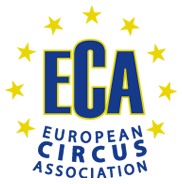CULTURAL RECOGNITION
The European Circus Association was established to promote and preserve circus culture in Europe, one of the most popular forms of live entertainment.
The modern European circus can be traced back to London around 1770, when Philip Astley opened his small arena near Waterloo Station. Astley presented a variety of acts including horseback riders, tightrope walkers, jugglers, acrobats and clowns. The individual traditions of these elements of Astley’s show go back many centuries. Combining all these skills and traditions in one show created what is now known as circus around the world, on all continents and regardless of political, religious or other influences. By its very nature, circus is a perfect example for the ability of mankind to live and work together despite different backgrounds, cultures, geographies, sex or religion.
During the 19th century many others all over Europe followed Astley’s example. Permanent theatres were built to house this new form of entertainment, some of them seating thousands of fascinated spectators. The early 20th century brought with it not just the circus tent, but also other technical innovations. European based Circuses were now able to literally travel the world and bring happiness anywhere from the Far East to South America, Africa and Australasia.
During the 20th century the circus encountered many difficulties in Europe, not only because the World Wars had dispersed many circus companies. Despite a comeback in the 1950’s, the circus had to face competition from cinema, television, amusement parks and other forms of entertainment.
Today more than 1,000 circuses operate all over Europe. Many are owned or managed by descendants of great circus families that handover their skills and talents from generation to generation. Some permanent circus buildings are still operational, among others in Paris, Munich, Madrid, Blackpool, Budapest, Bucharest, Riga and especially in Ukraine and Russia. The vast majority of circuses today, however, present their shows in custom made circus tents travelling from town to town all across Europe.
The classical circus, which is also known as an itinerant family-undertaking, offers a variety of entertaining acts incorporating acrobatics, comedy and trained animals. It has been entertaining, enchanting and educating children of all ages for many generations. Each circus has its individual focus. Some concentrate on the acrobatics, others on the animals or on the comedy, but in any case the mix of different “acts” and skills is essential for making up a “circus” program. In recent times, a more artistic approach to circus performances has evolved involving other arts, such as drama, theatre and dance. The combination of circus arts, music, light and dance in a modern artistic performance has opened up new perspectives for the circus.
There is no doubt that circus plays an important role in European art and culture. Initiated by the European Circus Association, the European Parliament adopted a resolution in 2005 stating that “it would be desirable for it to be recognized that the classical circus, including the presentation of animals, forms part of Europe’s culture.” The European Parliament called on the Commission to introduce specific measures to ensure that the circus is recognized as forming part of European culture and it urged the Member States who had not already done so to recognize the circus as forming part of Europe’s culture.
The European Circus Association continues to promote such cultural recognition for the circus throughout Europe.
